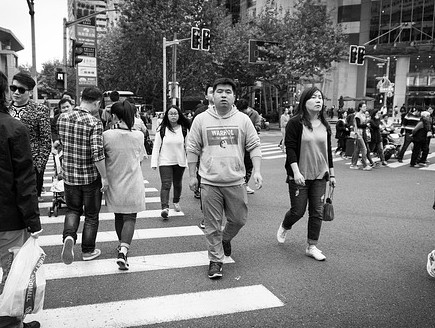May 2012 - As the diabetes epidemic spreads worldwide, there is growing concern for Asian American populations, who are nearly twice as likely to develop diabetes, particularly type 2 diabetes. Compounding the problem, many of the standard ways to detect diabetes fail in people of Asian descent.
"The medical profession needs to be aware of and address the unique characteristics of this population," said George L. King, M.D., Chief Scientific Officer at Joslin Diabetes Center and Professor of Medicine at Harvard Medical School (HMS). "Without this understanding, diabetes could be misdiagnosed or missed altogether."
Dr. King was lead author of nine diabetes specialists nationwide who collaboratively wrote an article published in the May 2012 edition of Diabetes Care highlighting a comprehensive range of research findings presented at an international symposium held in Honolulu in September 2011.
The authors compiled extensive data on various groups that comprise the Asian American population, encompassing immigrants from numerous East Asian countries and those born in the United States. They also studied diabetes incidence in Native Hawaiians and Pacific Islanders.
Although there are large differences in immigration patterns and lifestyle adaptations to U.S. culture among these groups, common threads and new insights are emerging. Researchers are finding significant differences in how diabetes affects the body's chemistry, how to view body weight, and why commonly used laboratory tests may not be reliable in Asian populations.
Continue Reading Below ↓↓↓
"Type 1 diabetes can be difficult to clinically differentiate from type 2 diabetes in Asians," said Dr. William C. Hsu, M.D., who with Dr. King co-directs the Asian American Diabetes Initiative at Joslin. Dr. Hsu, an Assistant Professor of Medicine at HMS, was lead author of a team of 12 experts who wrote a second article published in the same edition of Diabetes Care. These authors focused on the pathophysiology, or the disease process, of diabetes.
Type 1 diabetes is relatively rare in Asians, with incidence five to 10 times lower than in people of European descent. But diagnosing the disease is more difficult because genetic markers and blood factors generally associated with type 1 diabetes are present in only 30 percent of patients of Asian descent. In other words, simply relying on conventional tests would lead to misdiagnosis of a large percentage of Asians who have type 1 diabetes. More research is needed to learn what other biological factors in Asians patients lead to the destruction of insulin-making beta cells, resulting in type 1 diabetes. Lab tests then could be developed to detect these specific factors.
Type 2 diabetes is the most common form of diabetes in Asian Americans, with prevalence of diagnosed cases in recent years jumping from approximately 1 or 2 percent to 10 percent today, compared with 6 percent in the general population. Many others are undiagnosed or at risk, falling into the "pre-diabetes" category. In type 2 diabetes, the pancreas produces insulin but not enough, or the body's cells resist its effect. A risk factor commonly associated with type 2 diabetes is excess weight, often measured by calculating the body mass index (BMI).
But for Asian Americans with type 2 diabetes, the average BMI is between 24 and 25, well within the normal BMI range (19-25) for the general population.
"The BMI in Asian patients can be misleading. They can look quite skinny," Dr. Hsu said. "Instead, we're learning that a better indicator of type 2 diabetes risk in Asians is fat deposits at the waistline." More research is needed to understand how visceral fat contributes to the onset of type 2 diabetes. If detected in the pre-diabetes stage, the disease often can be prevented.
To diagnose diabetes, a commonly used tool�the fasting plasma glucose�fails to detect abnormal glucose tolerance in many Asian Americans. The authors recommend the oral glucose tolerance test, which although more cumbersome to do, has greater sensitivity and reliability in Asian populations.
Per diabetes complications, physicians need be aware that Asian Americans with diabetes tend to have a lower incidence of cardiovascular disease but higher rates of end-stage renal disease. These patients need to be monitored and treated accordingly.
Per treatments for diabetes, the authors cited the need for more studies: "The unique features of diabetes pathophysiology within this very heterogeneous population may indicate a need for different treatment guidelines." Insulin dosing, oral medications and lifestyle factors such as exercise and nutrition should be enfolded into a diabetes care program tailored to individuals, families and cultural practices.
The team of experts at Joslin's Asian Diabetes Initiative has found that educational materials are most effective when published in both the Asian language and English, allowing younger and older generations to communicate fluidly. Joslin also has developed multilingual websites.
Community-based education programs, which also have proved to be highly effective, need to be expanded. And in national data collection, it is important to include Asian groups as subsets of the general population, with culturally appropriate methods incorporated into the design of surveys.
Continue Reading Below ↓↓↓
"While there is much to be gained from ethnically sensitive care, these considerations are only a starting point," Dr. Hsu said. "Ultimately, all diabetes care needs to be tailored to the individual. That's the direction that medicine is going, and all populations will benefit."
Source: Joslin Diabetes Center









